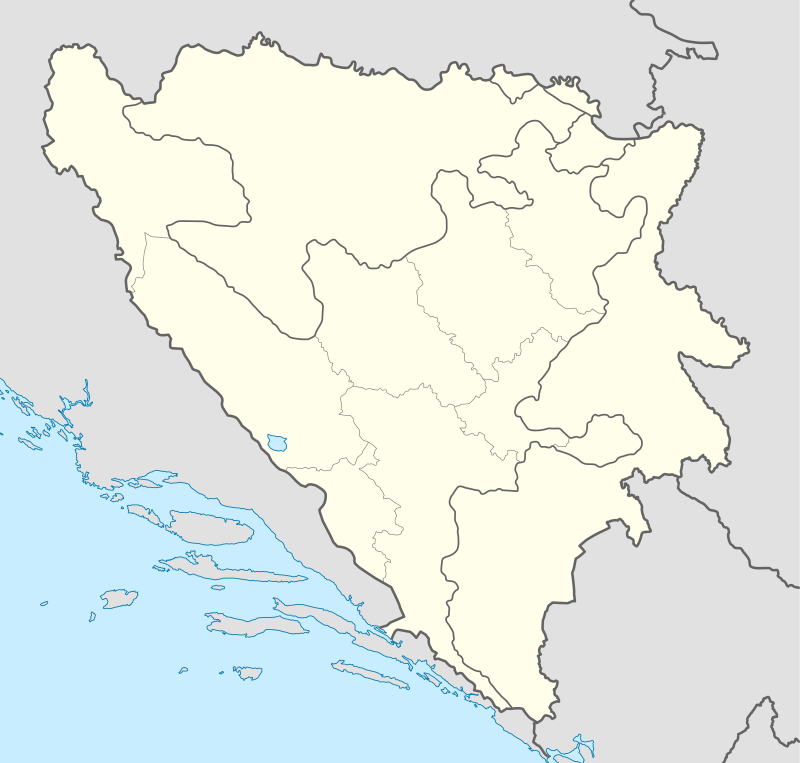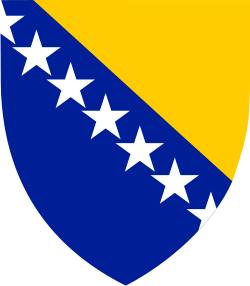Armed Forces of Bosnia and Herzegovina
| Armed Forces of Bosnia and Herzegovina Oružane snage Bosne i Hercegovine | |
|---|---|
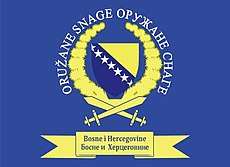 Coat of Arms of the Armed Forces of BiH | |
| Service branches |
Ground Forces Air Force and Aircraft Defence |
| Headquarters | Sarajevo |
| Leadership | |
| Commander-in-Chief | Presidency |
| Minister of Defense | Marina Pendeš[1] |
| Chairman of the Joint Staff and Commander | Maj. Gen.Senad Mašović [1] |
| Manpower | |
| Military age | 18 years of age |
| Conscription | Abolished in 2006 |
| Available for military service |
1,190,445 males, age 18–49 (2014 est.), 1,140,888 females, age 18–49 (2014 est.) |
| Fit for military service |
991,569 males, age 18–49 (2014 est.), 951,780 females, age 18–49 (2014 est.) |
| Reaching military age annually |
50,870 males (2014 est.), 65,789 females (2014 est.) |
| Active personnel | 9,200[1] |
| Reserve personnel | 4,600[1] |
| Deployed personnel |
|
| Expenditures | |
| Budget | around €150 million |
| Percent of GDP | 0.41% (2018.) |
| Industry | |
| Domestic suppliers |
"Zrak" d. d. Sarajevo PD "Igman" Konjic Ginex d.d. Goražde "Orao" AD Bijeljina UNIS Promex Sarajevo BNT Travnik "Binas" d. d. Bugojno Fabrika specijalnih vozila TRZ Hadžići Vitezit |
| Foreign suppliers |
|
| Related articles | |
| History |
Army of the Republic of Bosnia and Herzegovina Army of the Federation of Bosnia and Herzegovina Bosnian Serb Army History of the Army of Republic of Bosnia and Herzegovina Patriotic League Territorial Defence Force of the Republic of Bosnia and Hercegovina |
| Ranks | Military ranks and insignia of Bosnia and Herzegovina |
| Bosnian Ground Forces | |
|---|---|
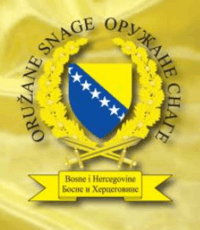 Bosnian Ground Forces Emblem | |
| Active | 2006-present |
| Country | Bosnia and Herzegovina |
| Branch | Army |
| Role | Ground defence of Bosnia and Herzegovina |
| Size | 12,806 |
| Garrison/HQ | Sarajevo |
| Motto(s) | "Perspektiva" ("Perspective")[1] |
| Commanders | |
| Notable commanders |
Brigadir Emir Kliko Brigadir Zdravko Rezo Radovan Jović |
The Armed Forces of Bosnia and Herzegovina (OSBiH; Serbo-Croat-Bosnian: Oružane snage Bosne i Hercegovine/Оружане снаге Босне и Херцеговине, ОСБИХ) is the official military force of Bosnia and Herzegovina. The BiH Armed forces were officially unified in 2005 and are composed of two founding armies: the Bosniak-Croat Army of the Federation of Bosnia and Herzegovina and the Bosnian Serbs' Army of Republika Srpska (VRS).
The Ministry of Defense of Bosnia and Herzegovina, founded in 2004, is in charge of the Armed Forces of Bosnia and Herzegovina.
Chain of command
In accordance with the BiH Constitution (Article 5.5a), BiH Law of defense and BiH Law of service the supreme civilian commander of the Armed Forces Bosnia and Herzegovina is the collective Presidency of Bosnia and Herzegovina. The collective Presidency directs the Ministry of defense BiH and the Armed Forces. Former Bosnia and Herzegovina ministers of defense include H.E. Nikola Radovanović, H.E. Selmo Cikotić and H.E. Muhamed Ibrahimović. The current Minister of defense BiH is H.E. Marina Pendeš. Former Chiefs of Joint Staff AF BiH include LGEN Sifet Podžić, Lieutenant General Miladin Milojčić and Lieutenant General Anto Jeleč. The current BiH Chief of Joint Staff is Major General Senad Mašović. Conscription was completely abolished in Bosnia and Herzegovina effective on and from 1 January 2006.[2]
Defence law
The Bosnia and Herzegovina Defence Law addresses the following areas: the Military of Bosnia and Herzegovina, Government Institutions, Entity Jurisdictions and Structure, Budget and Financing, Composition of Armed Forces of Bosnia and Herzegovina, War Declaration, natural disasters, conflict of interests and professionalism, Oath to Bosnia-Herzegovina, flags, anthem and military insignia, and transitional and end orders.
History
The AFBiH was formed from three armies of the Bosnian War period: the Bosnian (dominantly Bosniak with numbers of Serbs and Croats) Army of the Republic of Bosnia and Herzegovina, the Bosnian Serb Army of Republika Srpska, and the Croat Defence Council.
The Army of the Republic of Bosnia And Herzegovina was created on 15 April 1992 during the early days of the Bosnian War. Before the ARBiH was formally created, there existed Territorial Defence, an official military force of Republic of Bosnia and Herzegovina, and a number of paramilitary groups such as the Green Berets, Patriotic League, and civil defense groups, as well as many criminal gangs and collections of police and military professionals. The army was formed under poor circumstances, with a very low number of tanks, APCs and no military aviation assets. The army was divided into Corps, each Corp was stationed in a territory. The first commander was Sefer Halilović.
The Army of Republika Srpska was created on 12 May 1992. Before the VRS was formally created, there were a number of paramilitary groups such as the Srpska Dobrovoljačka Garda, Beli Orlovi, as well as some Russian, Greek and other volunteers. The army was equipped with ex-JNA inventory. It had about 200 tanks, mostly T-55s and 85 M-84s, and 150 APCs with several heavy artillery pieces. The Air Defense of VRS has shot down several aircraft, like F-16, Mirage 2000, F-18 and one Croatian Air Force MiG-21. The VRS received support from the Yugoslav Army and FRY.
The Croatian Defence Council was the main military formation of the Croatian Republic of Herzeg-Bosnia during the Bosnian War. It was first organized military force to with the aim to control the Croat populated areas, created on 8 April 1992. They ranged from men armed with shotguns assigned to village defense tasks to organized, uniformed, and well-equipped brigade-sized formations that nevertheless employed part-time soldiers. As time went on, the HVO forces became increasingly better organized and more "professional", but it was not until early 1994, that the HVO began to form the so-called guards brigades, mobile units manned by full-time professional soldiers.
In 1995–96, a NATO-led international peacekeeping force (IFOR) of 60,000 troops served in Bosnia and Herzegovina, beginning on December 21, 1995 to implement and monitor the military aspects of the Dayton Peace Agreement. IFOR was succeeded by a smaller, NATO-led Stabilization Force or SFOR. The number of SFOR troops was reduced first to 12,000 and then to 7,000. SFOR was in turn succeeded by an even smaller, European Union-led European Union Force, EUFOR Althea. As of 2004, EUFOR Althea numbered around 7,000 troops.
The Dayton Peace Agreement left the country with three armies under two commands: the Bosniak and Bosnian Croat armies within the Federation of Bosnia and Herzegovina, facing their recent adversaries the Army of the Republika Srpska. These three forces together had around 419,000 personnel in regulars and reserves.[3] This force size and orientation was totally at odds with the international peacemakers' vision. Slow reductions did take place. By 2004, the two warring factions had reduced their forces to 12,000 regulars and 240,000 reserves but had made virtually no progress in integrating the two into one new force, though the basis of a state defence ministry had been put in place via the Standing Committee on Military Matters (SCMM). Conscription for periods of around four months continued, the costs of which were weighing down both entities.
The restructuring of the three armies into the Armed Forces of Bosnia and Herzegovina represents part of a wider process of 'thickening' the central state institutions in Bosnia and Herzegovina.[4] In order to mitigate some of the potential controversy around restructuring, the Office of the High Representative (OHR) made use of evidence of malpractice in Republika Srpska military institutions. Firstly, from 2002 onwards, OHR utilised a scandal around the provision of parts and assistance to Iraq in breach of a UN embargo (the so-called Orao affair) to support the cause for bringing governance of the armies under the level of central institutions.[5] Following this, in 2004, the process was accelerated,[6] drawing its justification from new evidence of material and other forms of support flowing from Republika Srpska armed forces to ICTY indictee Ratko Mladić. OHR condemned the ‘systematic connivance of high-ranking members of the RS military’ and noted that measures to tackle such systematic deficiencies were under consideration.[7] This was quickly followed by the expansion of the mandate for a Defence Reform Commission, which ultimately resulted in the consolidation of three armed forces into one, governed at the level of the central state.[8]
As the joint AFBiH began to develop, troops began to be sent abroad. Bosnia and Herzegovina deployed a unit of 37 men to destroy munitions and clear mines, in addition to 6 command personnel as part of the Multinational force in Iraq. The unit was first deployed to Fallujah, then Talil Air Base, and is now located at Camp Echo. In December 2006, the Bosnian government formerly extended its mandate through June 2007. Bosnia and Herzegovina is planning to send another 49 soldiers from the 6th Infantry Division to Iraq in August 2008, their mission will be to protect/guard Camp Victory in Baghdad.
Structure


The Military units are commanded by the Armed Forces of Bosnia and Herzegovina Joint Staff in Sarajevo. There are two major commands under the Joint Staff: Operational Command and Support Command.
There are three regiments that are each formed by soldiers from the three ethnic groups of Bosnia and Herzegovina: Bosniaks, Croats and Serbs and trace their roots to the armies that were created during the war in BiH. These regiments have their distinct ethnic insignias and consist of three active battalions each. Headquarters of Regiments have no operational authority. On the basis of the Law on Service in the Armed Forces of Bosnia and Herzegovina, the regimental headquarters have the following tasks: to manage the regimental museum, monitor financial fund Regiment, prepare, investigate and cherish the history of the regiment, the regiment publish newsletters, maintain cultural and historical heritage, give guidance on holding special ceremonies, give guidance on customs, dress and deportment Regiment, conduct officer, NCO and military clubs. Each regiments three battalions divided evenly between the three active brigades of the Army.
Joint Staff of the Armed Forces of Bosnia and Herzegovina
| Name | Headquarters | Information | Chief |
|---|---|---|---|
| Operational Command[9] | Sarajevo | The main command center of the Armed Forces of Bosnia and Herzegovina. | Senad Mašović |

Brigades under the Operational Command control
| Name | Headquarters | Information | Chief |
|---|---|---|---|
4th Infantry Brigade |
Čapljina | Zdravko Rezo | |
5th Infantry Brigade |
Tuzla | Emir Kliko | |
6th Infantry Brigade |
Banja Luka |
|
Radovan Jović |
| Tactical Support Brigade | Sarajevo | Amir Čorbo | |
| Air Force & Anti-Air Defense Brigade[10] | Rajlovac Banja Luka |
|
Dragan Nakić |
Brigades under the Support Command control
| Name | Headquarters | Information |
|---|---|---|
| Personnel Command | Banja Luka |
|
| Logistics Command | Travnik Doboj |
|
Within the armed forces, there are a number of services. These include a Technical Service, Air Technology service, Military Police service, Communications service, Sanitary service, a Veterans service, Civilian service, Financial service, Information service, Legal service, Religious service, and a Musical service.
Uniform and Insignia
Armed Forces of Bosnia and Herzegovina were unified in 2005 and at that time they needed a uniform for the newly founded army. MARPAT was designated as the future uniform of AFBiH.
Insignia is found on military hats or berets, on the right and left shoulder on the uniform of all Soldiers of the Armed Forces. All, except for generals, wear badges on their hats or berets with either the land force badge or air force badge. Generals wear badges with the coat of arms of Bosnia surrounded with branches and two swords.All soldiers of the armed forces have on their right shoulder a flag of Bosnia and Herzegovina. All members of the three regiments wear their regiment insignia on the left shoulder. There are other insignias, brigades or other institution are worn under the regiment insignia. The name of the soldiers is worn on the left part of the chest while the name "Armed Forces of BiH" is worn on the right part of the chest.
Weapons
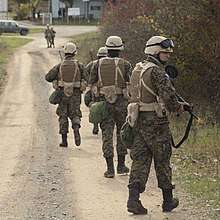
Small arms

Machine guns
.jpg)
Armor
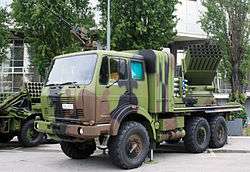
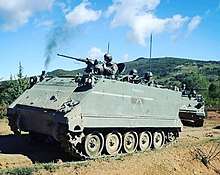
Air Force
The Air Force and Anti-Aircraft Defence Brigade of Bosnia and Herzegovina was formed when elements of the Army of the Federation of Bosnia and Herzegovina and the Republika Srpska Air Force were merged in 2006. The status of the Air Force in the last couple of years, has merged a great success. While saying so, it includes aircraft repairs, funds for professional and proper cooperation with the Ground Forces, as well as to the citizens of the country. The Ministry of Defense of Bosnia and Herzegovina is in great interest of buying new aircraft's, that include mostly helicopters and perhaps even fighter jets.[16]
Squadrons
- 1st Helicopter Squadron - Sarajevo Airport
- 2nd Helicopter Squadron - Banja Luka Airport
- 3rd Helicopter Squadron - Tuzla Airport
- Air Defense Battalion
- 1st Air Defence Battalion - Sarajevo Airport
- 2nd Air Defence Battalion - Banja Luka Airport
- 3rd Air Defence Battalion - Tuzla Airport
- Early Warning and Surveillance Battalion
- Flight Support Battalion
Aircraft
| Aircraft | Origin | Type | Variant | In service | Notes | |
|---|---|---|---|---|---|---|
| Helicopters | ||||||
| Mil Mi-8 | Russia | utility / transport | Mi-8/17 | 6[17] | ||
| Eurocopter AS332 Super Puma | France | transport / attack | 12 on order | |||
| Bell UH-1 | United States | utility | UH-1H | 5[17] | ||
| Aérospatiale Gazelle | France | utility | SA341/42 | 9[17] | ||
.jpg)
Future aircraft acquisition
Bosnia and Herzegovina will spend BAM 300 million on 12 new Eurocopter AS332 Super Puma helicopters in the period 2016 - 2025[18]
Air Defense
| Name | Origin | Type | In service | Notes | ||
|---|---|---|---|---|---|---|
| SAM | ||||||
| 9K34 Strela-3[19] | Soviet Union | MANPADS | ||||
| FIM-92 Stinger[20] | United States | MANPADS | ||||
| 9K38 Igla[19] | Soviet Union | MANPADS | ||||
| 2K12 Kub | Soviet Union | mobile SAM system | 20[21] | |||
| 9K31 Strela-1[22] | Soviet Union | mobile SAM system | ||||
| SA-13[19] | Soviet Union | mobile SAM system | ||||
| Bofors 40 mm gun[23] | Sweden | Anti-aircraft gun | 47[24] | |||
| M53/59 Praga | Czechoslovakia | SPAAG | 96[24] | |||
| ZU-23-2 | Soviet Union | Anti-aircraft gun | 30[24] | |||
References
- 1 2 3 4 5 "MINISTARSTVO ODBRANE I ORUŽANE SNAGE BOSNE I HERCEGOVINE" (PDF). Mod.gov.ba. Retrieved 4 January 2018.
- ↑ "NATO and the Defence Reform Commission: partners for progress". Setimes.com. Retrieved 4 January 2018.
- ↑ HQ SFOR's Joint Military Affairs and BiH Defence Reform, First published in SFOR Informer#171, June, 2004.
- ↑ Aitchison, Andy (2013). "Governing through Crime Internationally? Bosnia and Herzegovina". British Journal of Politics and International Relations. 15 (4): 558. doi:10.1111/j.1467-856X.2012.00521.x.
- ↑ Ashdown, Paddy (2007). Swords and Ploughshares: Bringing Peace to the 21st Century. London: Weidenfeld and Nicolson. pp. 248–250. ISBN 978-0297853039.
- ↑ Ashdown, Paddy (2007). Swords and Ploughshares: Bringing Peace to the 21st Century. London: Weidenfeld and Nicolson. p. 294. ISBN 978-0297853039.
- ↑ "ICTY Failure the Main Obstacle to PfP Membership for a Second Time". Office of the High Representative. Retrieved 18 June 2012.
- ↑ "Decision Extending the Mandate of the Defence Reform Commission". Office of the High Representative. Retrieved 18 June 2002.
- ↑ "Archived copy". Archived from the original on 2016-03-16. Retrieved 2015-04-15.
- ↑ "Struktura". mod.gov.ba. Retrieved 2018-05-30.
- 1 2 3 4 5 6 7 8 9 10 11 12 13 14 15 16 17 18 19 20 21 22 23 24 25 26 27 28 29 30 31 32 33 34 35 36 37 38 39 40 41 42 43 44 45 46 47 48 49 "Bosnia Herzegovina Land Forces military equipment, armament and vehicles Army". Armyrecognition.com. Retrieved 2014-10-15.
- 1 2 3 4 5 6 7 8 9 10 11 12 13 14 15 16 17 18 19 20 21 22 23 24 25 26 27 SIPRI Arms Transfers Database
- ↑ |50 units donated by the UAE in 1997. 36 in service, others in storage for spare parts. Lamb, Christopher J. (March 2014). Arkin, Sarah; Scudder, Sally, eds. The Bosnian Train and Equip Program: A Lesson in Interagency Integration of Hard and Soft Power (PDF). Washington, D.C., USA.: National Defense University Press Washington, D.C.
- ↑ "US donates 44 HMMWV's to Bosnia and Herzegovina - AM General". AM General. Retrieved 2018-03-30.
- 1 2 3 Ioannis Michaletos (2012). "DEFENSE BALANCE IN WESTERN BALKANS". Rieas.gr. Retrieved 2013-10-01.
- ↑ "Bosnia breaks through ethnic divide by merging Serb, Muslim-Croat forces". Stars and Stripes. 11 January 2006. Retrieved 13 March 2015.
- 1 2 3 "World Air Forces 2018". Flightglobal Insight. 2018. Retrieved 14 January 2018.
- ↑ "Održana 37. sjednica Vijeća ministara Bosne i Hercegovine". www.vijeceministara.gov.ba. Retrieved 2017-11-26.
- 1 2 3 Administrator. "Bosnia Herzegovina army land ground armed defense forces military equipment armored vehicle UK | Bosnia Herzegovina army land ground forces UK | East Europe UK". www.armyrecognition.com. Retrieved 2018-02-24.
- ↑ https://www.militaryfactory.com/smallarms/detail.asp?smallarms_id=30
- ↑ IISS 2012 Military Balance, pp. 97
- ↑ Administrator. "SA-9 Gaskin 9K31 Strela-1 ground to air missile system technical data sheet specifications | Russia Russian missile system vehicle UK | Russia Russian army military equipment vehicles UK". www.armyrecognition.com. Retrieved 2018-02-24.
- ↑ Faktor.ba. "Haubice, transporteri, raketni bacači i snajperi: Oružane snage BiH predstavile vojnu opremu (FOTO)". Retrieved 2018-02-24.
- 1 2 3 Administrator. "Bosnia Herzegovina army land ground armed defense forces military equipment armored vehicle UK | Bosnia Herzegovina army land ground forces UK | East Europe UK". www.armyrecognition.com. Retrieved 2018-05-26.
Further reading
- Jim Dorschner, 'Endgame in Bosnia,' Jane's Defence Weekly, 18 April 2007, p. 24–29
